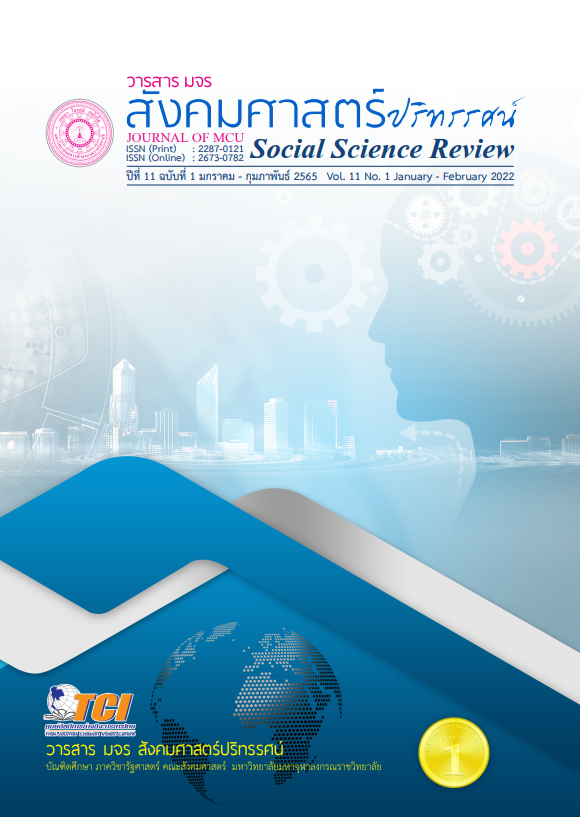การปฏิรูปการบริหารจัดการภาครัฐตามแนวคิดการจัดการภาครัฐแนวใหม่ ในสาธารณรัฐประชาธิปไตยประชาชนลาว : กรณีศึกษากระทรวงโยธาธิการและการขนส่ง
คำสำคัญ:
การบริหารภาครัฐแนวใหม่, การปฏิรูปการจัดการภาครัฐ, กระทรวงโยธาธิการและการขนส่งบทคัดย่อ
บทความวิจัยนี้มุ่งที่จะศึกษาถึงการนำแนวคิดบริหารภาครัฐแนวใหม่ (New Public Management: NPM) มาปรับใช้ในการปฏิรูปการจัดการภาครัฐในสาธารณรัฐประชาธิปไตยประชาชนลาว (สปป.ลาว) กรณีศึกษาของกระทรวงโยธาธิการและการขนส่ง เพื่อให้รับรู้ถึงแนวทางและความท้าทายในการปฏิรูปดังกล่าว จากการปรับใช้ NPM บทความวิจัยนี้ใช้วิธีการวิจัยเชิงคุณภาพโดยเก็บข้อมูลจากการสัมภาษณ์เชิงลึกบุคลากรภาครัฐจำนวน 10 คน และจากแหล่งข้อมูลเอกสารของภาครัฐจากอดีตถึงปัจจุบัน ข้อมูลที่ได้นำมาวิเคราะห์โดยใช้การค้นหาแก่นสาระ
ผลการวิจัยพบว่า สปป.ลาว ได้นำแนวทางการบริหารจัดการภาครัฐแนวใหม่มาใช้ในการปฏิรูปภาครัฐในด้านต่าง ๆ เช่น การลดขนาดองค์กร การปรับปรุงโครงสร้างของรัฐบาล และการเปลี่ยนไปสู่การแข่งขันตามกลไกของตลาดที่มากขึ้นภายในหน่วยงานภาครัฐ ซึ่งแนวความคิดเหล่านี้ได้ถูกยอมรับและนำไปใช้ในกระทรวงโยธาธิการและการขนส่งด้วยเช่นกัน อย่างไรก็ตาม แนวคิด NPM ไม่ได้ถูกนำมาใช้อย่างครบถ้วน แต่ถูกปรับและนำไปใช้โดยพิจารณาจากสถานการณ์และระบบของกระทรวง รวมถึงมุมมองทางการเมือง ในขณะเดียวกันยังพบความท้าทายบางประการเช่น โครงสร้างระบบการบริหาร สภาพเศรษฐกิจและสังคม รวมทั้งการขาดงบประมาณในการปฏิรูป โครงสร้างรูปแบบองค์กรที่ซับซ้อนยากต่อการเปลี่ยนแปลง และความสามารถของบุคลากร ซึ่งทำให้การปฏิรูปภาครัฐใน สปป.ลาว รวมถึงในกระทรวง ตามแนวทางดังกล่าวค่อนข้างล่าช้า
เอกสารอ้างอิง
Hood, C. (1991). A public management for all seasons?. London: Royal Institute of Public Administration.
Hughes, O. E. (2012). Public managment and administration: An introduction. New York: Palgrave Macmillan.
Kattiyasack, S. (2018). Result of Work Implementation in 2017-2018 and Direction of 2019-2020 of MPWT. Vientiane Capital: Ministry of Public Works and Transport.
Ministry of Finance (2020). Focused measures of Laos government to save public expenditure in 2021. Retrieved November 30, 2020, from http://www.mof.gov.la/index.php/2020/22/03/2021-laiymarttakarn/
Ministry of Public Works and Transport. (2006). Development plan of ICT. Vientiane Capital: The Ministry.
_______. (2015). Five Year Development Plan (2016-2020) of Public Works and Transport Sector. Vientiane Capital: The Ministry
_______. (2019). Instruction No. 05949/PWT.CO on Regulation Enformcement for Management of Investment Permission in Public Works and Transport Sector. Vientiane Capital: The Ministry.
O'Neill, A. (2021). Gross domestic product of the ASEAN countries from 2010 to 2020. Statista, Retrieved April 1, 2021, from https://www.statista.com/statistic/796245/gdp-of-the-asean-countries
Onxayvieng, C. & Tan, S. (2015). Public personnel administration reform: effect on civil service management and innovation in Lao PDR. International Institute for Science, Technology and Education (IISTE), 19.
Pfiffner, J. P. (2004). In Benz, H. S. & Sommermann, K. P. (Eds). Traditional Public Administration versus The New Public Management: Accountability versus Efficiency. (pp.443-454). Berlin: Institutionen bildung in Regierung und Verwaltung: Festschrift fur Klaus Konig.
Slater, R. & Keoka, K. (2012). Trend in the Governance Sector of the Lao PDR. Vientiane Capital: Swiss Agency for Development and Cooperation.
The World Bank. (2014). Water Supply and Sanitation in Lao PDR: Turning Finance into Service for the Future. Lao PDR: The World Bank.
ดาวน์โหลด
เผยแพร่แล้ว
รูปแบบการอ้างอิง
ฉบับ
ประเภทบทความ
สัญญาอนุญาต
ลิขสิทธิ์ (c) 2022 วารสาร มจร สังคมศาสตร์ปริทรรศน์

อนุญาตภายใต้เงื่อนไข Creative Commons Attribution-NonCommercial-NoDerivatives 4.0 International License.
เพื่อให้เป็นไปตามกฎหมายลิขสิทธิ์ ผู้นิพนธ์ทุกท่านต้องลงลายมือชื่อในแบบฟอร์มใบมอบลิขสิทธิ์บทความให้แก่วารสารฯ พร้อมกับบทความต้นฉบับที่ได้แก้ไขครั้งสุดท้าย นอกจากนี้ ผู้นิพนธ์ทุกท่านต้องยืนยันว่าบทความต้นฉบับที่ส่งมาตีพิมพ์นั้น ได้ส่งมาตีพิมพ์เฉพาะในวารสาร มจร สังคมศาสตร์ปริทรรศน์ เพียงแห่งเดียวเท่านั้น หากมีการใช้ภาพหรือตารางหรือเนื้อหาอื่นๆ ของผู้นิพนธ์อื่นที่ปรากฏในสิ่งตีพิมพ์อื่นมาแล้ว ผู้นิพนธ์ต้องขออนุญาตเจ้าของลิขสิทธิ์ก่อน พร้อมทั้งแสดงหนังสือที่ได้รับการยินยอมต่อบรรณาธิการ ก่อนที่บทความจะได้รับการตีพิมพ์ หากไม่เป็นไปตามข้อกำหนดเบื้องต้น ทางวารสารจะถอดบทความของท่านออกโดยไม่มีข้อยกเว้นใดๆ ทั้งสิ้น





